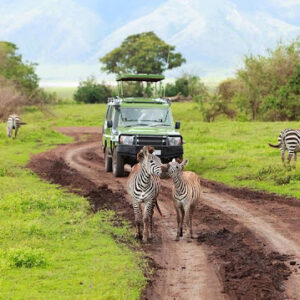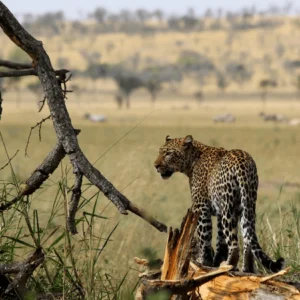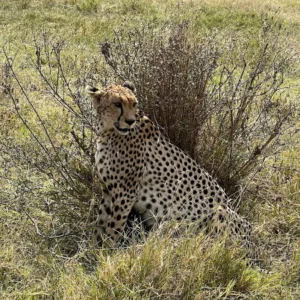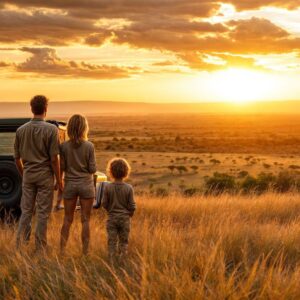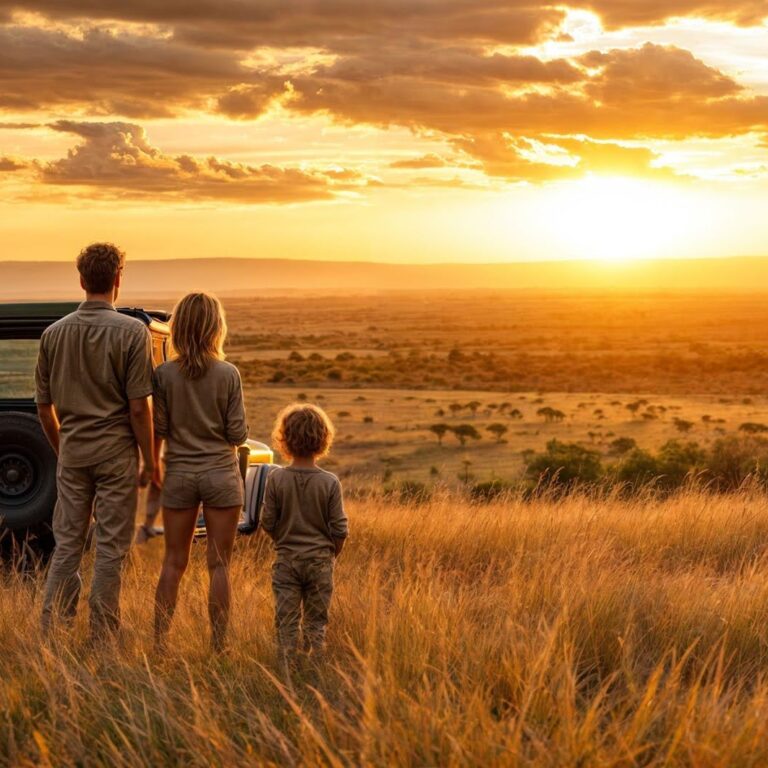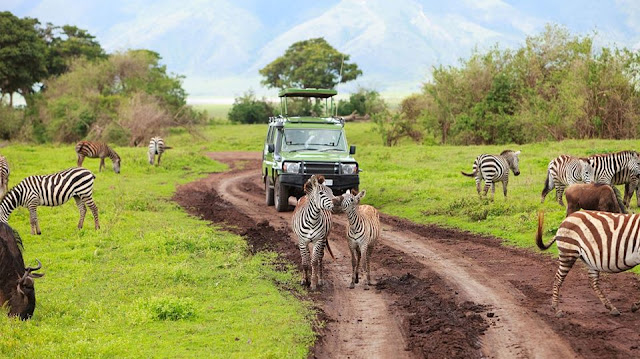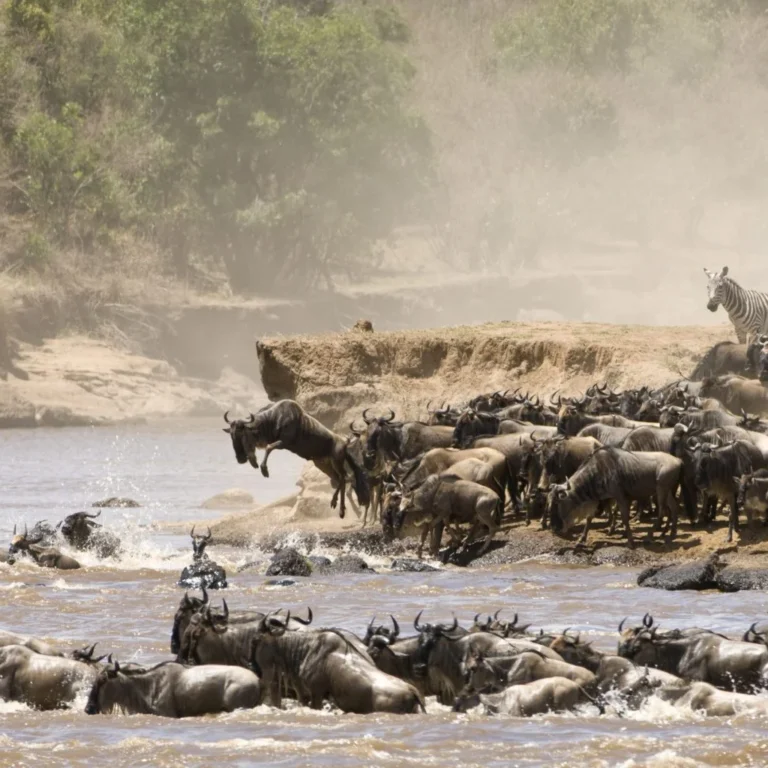The Ultimate Guide to Visiting the Ngorongoro Crater
Discover the Ngorongoro Crater, often called the “Eighth Wonder of the World,” is a destination that stirs the imagination of travelers worldwide. This magnificent natural amphitheater, nestled in northern Tanzania, is a geological marvel, a wildlife haven, and a cultural treasure trove. Whether you’re a seasoned explorer or a first-time visitor to Africa, this guide will provide you with everything you need to know to make the most of your journey to the Ngorongoro Crater.
1. History and Geology of the Ngorongoro Crater
The story of the Ngorongoro Crater begins millions of years ago with a massive volcanic eruption that shaped one of the most extraordinary landscapes on Earth. The volcano, once a towering peak as high as Mount Kilimanjaro, collapsed upon itself, forming a caldera approximately 610 meters deep and 20 kilometers in diameter. Today, this caldera, commonly referred to as the Ngorongoro Crater, stands as the largest unbroken and unflooded caldera in the world.
The Crater’s formation is a testament to the raw, transformative power of nature. Over time, the volcanic soil enriched the land, fostering an ecosystem teeming with life he Maasai people, who have lived in harmony with this land for centuries, refer to it as “El-Nkoronkoro,” meaning “Gift of Life,” a name that perfectly encapsulates the Crater’s significance to both nature and humanity.
2. Why Ngorongoro Crater is a Must-Visit Destination
Visiting the Ngorongoro Crater is like stepping into a wildlife documentary. The Crater’s unique geography creates a microcosm of East Africa’s diverse ecosystems. From open savannahs and acacia forests to wetlands and salt pans. This diversity supports a staggering array of wildlife, making the Crater one of the most densely populated animal habitats on the planet.
The Crater is home to over 25,000 large animals, including the famous “Big Five”: lions, elephants, buffaloes, leopards, and the critically endangered black rhinoceros. The chance to see these animals, often at close range, draws nature lovers from around the world. The Crater’s relatively small size and enclosed nature make it one of the few places where you can be almost certain of spotting a wide variety of wildlife in a single day.
But the Ngorongoro Crater is more than just a haven for wildlife. It is also a place of profound cultural significance. The Maasai people continue to live and herd their cattle in the Ngorongoro Conservation Area, maintaining a way of life that has remained largely unchanged for centuries. Their presence adds a rich cultural layer to the experience of visiting the Crater, offering insights into a symbiotic relationship between people and nature.
3. How to Get to Ngorongoro Crater
Reaching the Ngorongoro Crater is an adventure in itself. Most visitors begin their journey in Arusha, a vibrant town that serves as the gateway to northern Tanzania’s safari circuit. Arusha is well-connected by air, with Kilimanjaro International Airport (JRO) being the most convenient entry point for international travelers. From Arusha, the Crater is a scenic 3 to 4-hour drive, passing through the rolling plains of the Great Rift Valley and the lush highlands of Karatu.
If you’re traveling from other parts of Tanzania, you can also fly into Lake Manyara Airport or take a longer drive from Serengeti National Park. The roads to the Crater are generally well-maintained, but a 4×4 vehicle is recommended, especially during the rainy season when some routes can become challenging.
4. Best Time to Visit Ngorongoro Crater
The Ngorongoro Crater is a year-round destination, but the experience can vary depending on the season.
Dry Season (June to October): This is the peak tourist season, characterized by clear skies, abundant wildlife sightings, and pleasant temperatures. The dry conditions make animals congregate around the remaining water sources, making them easier to spot. However, this is also the most crowded time, so expect higher prices and more vehicles in the Crater.
Wet Season (November to May): The wet season is split into two parts: the short rains (November to December) and the long rains (March to May). During this time, the Crater transforms into a lush, green paradise. The scenery is breathtaking, and it’s an excellent time for birdwatching, with migratory species arriving in large numbers. The Crater is also less crowded, offering a more serene experience. However, some roads may become muddy and more difficult to navigate.
5. Accommodation Options Around Ngorongoro Crater
Accommodations near the Ngorongoro Crater cater to a wide range of preferences and budgets, from luxurious lodges to budget-friendly campsites.
Luxury Lodges: For an indulgent experience, the Ngorongoro Crater Lodge and The Highlands Ngorongoro offer unparalleled luxury with stunning views of the Crater, gourmet dining, and personalized service. These lodges provide a perfect blend of comfort and proximity to nature, making them ideal for travelers seeking an upscale safari experience.
Mid-Range Options: Ngorongoro Sopa Lodge and Rhino Lodge are popular mid-range options that offer comfortable accommodations with easy access to the Crater. These lodges are well-appointed and provide excellent value, combining comfort with the adventure of being close to the wild.
Budget-Friendly Campsites: For travelers on a budget or those looking to immerse themselves more fully in nature, Simba Campsite is a great choice. Located on the Crater rim, this campsite offers basic facilities but unbeatable views and a truly authentic experience.
6. Top Things to Do in Ngorongoro Crater
The Ngorongoro Crater offers a wealth of activities that cater to different interests, ensuring that every visitor finds something to treasure.
Game Drives: A game drive through the Crater is the quintessential safari experience. With a high density of wildlife, including lions, elephants, and the rare black rhinoceros, every drive is filled with anticipation and wonder. Early morning drives are especially rewarding, as the animals are most active at dawn.
Bird Watching: With over 500 bird species recorded, the Crater is a birdwatcher’s paradise. Look out for the striking Kori Bustard, the world’s heaviest flying bird, and flocks of flamingos that often gather around Lake Magadi.
Cultural Tours: Visiting a Maasai village offers a fascinating glimpse into the traditional lifestyle of one of Africa’s most iconic tribes. Engage with the Maasai people, learn about their customs, and experience their famous jumping dance, known as the “Adumu.”
Guided Walks: For those who prefer to explore on foot. Guided walks along the Crater rim provide stunning panoramic views and a deeper connection to the landscape. These walks offer a chance to learn about the local flora and fauna from experienced guides.
Picnicking at Lake Magadi: After a morning of game viewing, there’s nothing quite like enjoying a picnic by Lake Magadi. Surrounded by the sounds of nature, this is a perfect spot to relax and soak in the Crater’s beauty.
7. Wildlife You Can Expect to See
The Ngorongoro Crater is renowned for its exceptional wildlife viewing opportunities. Some of the animals you can expect to see include:
Lions: The Crater is famous for its large lion population, often seen lounging in the open grasslands or stalking prey. The lions here are known for their robust size, attributed to the Crater’s rich ecosystem.
Black Rhinoceros: One of the highlights of visiting the Crater is the opportunity to see the critically endangered black rhinoceros. The Crater is one of the few places in East Africa where these magnificent animals can still be observed in the wild.
Elephants: Although not as numerous as in other parks. The elephants in the Crater are remarkable for their large tusks, which are a result of the mineral-rich vegetation.
Zebras and Wildebeest: The Crater is home to large herds of zebras and wildebeest, often seen grazing side by side. These animals play a crucial role in the Crater’s ecosystem, supporting predators like lions and hyenas.
Hippos: The Crater’s water bodies, such as Lake Magadi, are teeming with hippos. These massive creatures are often seen wallowing in the water to stay cool during the day.
8. Conservation Efforts in Ngorongoro Crater
The Ngorongoro Crater is not just a natural wonder; it is also a conservation success story. The Crater is part of the larger Ngorongoro Conservation Area (NCA), a unique blend of wildlife protection and human habitation. The Ngorongoro Conservation Area Authority (NCAA) is responsible for managing the area. Ensuring that both the environment and the Maasai community coexist in harmony.
Conservation efforts in the Crater focus on preserving its unique biodiversity. Protecting endangered species, and maintaining the balance between wildlife and human activities. The NCAA also plays a crucial role in supporting the Maasai people. Who continue to practice traditional pastoralism within the conservation area.
9. Sustainable Tourism Practices
Sustainable tourism is critical for preserving the Ngorongoro Crater’s delicate ecosystem and ensuring that future generations can enjoy its wonders. Several measures have been put in place to minimize the environmental impact of tourism and to promote responsible travel.
Vehicle Limitations: To reduce overcrowding minimize environmental damage. Number of vehicles allowed in Crater given time strictly regulated. This helps prevent soil erosion and reduces stress on the wildlife.
Waste Management: Strict guidelines enforced regarding waste disposal. Tour operators and visitors required to carry out all waste, ensuring that the Crater remains pristine and free from litter. This initiative also helps protect the animals from ingesting harmful materials.
Eco-Friendly Lodges: Many lodges and camps in the Ngorongoro Conservation Area have adopted eco-friendly practices, such as using solar power, recycling water, and minimizing plastic use. By choosing to stay at these accommodations, visitors can contribute to the sustainability efforts in the region.
Community Involvement: Sustainable tourism in the Ngorongoro Crater also involves supporting the local Maasai community. Many tour operators offer cultural experiences that allow visitors to learn about Maasai traditions. While contributing to the community’s economic well-being. Additionally, a portion of the entrance fees to the Crater goes toward community development projects.
Guided Walking Tours: Walking tours along the Crater rim promoted as a low-impact way to experience the area’s natural beauty. These tours not only reduce the reliance on vehicles. Also provide visitors with a deeper appreciation of the Crater’s flora and fauna.
10. Planning Your Visit: Practical Tips
To make the most of your visit to the Ngorongoro Crater, careful planning is essential. Here are some practical tips to help you prepare for your adventure:
Entry Fees: The entrance fee for the Ngorongoro Crater is $70 per person per day. Additionally, there is a vehicle fee of $295 for a half-day visit. These fees contribute to the conservation efforts and help maintain the Crater’s unique environment. It’s advisable to carry cash or a credit card to pay the fees at the entrance.
Guided Tours: Hiring a knowledgeable guide can greatly enhance your experience. Guides well-versed in the Crater’s history, geology, and wildlife, providing valuable insights that you might otherwise miss. Most safari packages include a guide, but you can also arrange one independently if needed.
What to Pack: Pack clothing that is comfortable and suitable for both warm and cool weather. Layers recommended, mornings and evenings chilly, while midday temperatures can rise significantly. Don’t forget essentials like a hat, sunscreen, insect repellent, and a good pair of binoculars for wildlife viewing. A camera with a zoom lens is also a must for capturing the stunning landscapes and close-up shots of animals.
Health Precautions: The Ngorongoro Crater is located in a malaria-prone area, so it’s important to take appropriate precautions. Consult with your doctor about anti-malarial medication before your trip, and use insect repellent to protect against mosquito bites. Make sure your vaccinations are up-to-date, especially for diseases like yellow fever and typhoid.
Timing Your Visit: Arriving early in the morning recommended, the Crater gates open at 6:00 AM. Early morning game drives offer the best chance of seeing predators in action. As they are most active during the cooler hours. Plan for a half-day or full-day visit, depending on your schedule and interests.
Respect the Wildlife: While the animals in the Crater accustomed to vehicles, it’s important to respect their space. Always keep a safe distance, avoid loud noises, and never feed the animals. Remember that the Crater is their home, and we are mere visitors.
Stay Hydrated: The Crater’s high altitude can be deceivingly cool, but it’s important to stay hydrated, especially during game drives. Bring plenty of water and snacks, there limited facilities once you are inside the Crater.
Conclusion: A Journey of a Lifetime
Visiting the Ngorongoro Crater is a truly transformative experience. Offering a glimpse into a world where nature and culture coexist in perfect harmony. Whether you’re a wildlife enthusiast, a birdwatcher, or simply someone seeking the thrill of an African safari, the Crater promises an unforgettable adventure.

